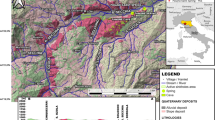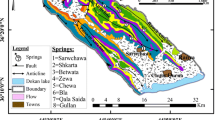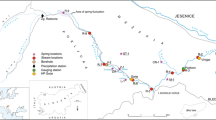Abstract
This paper focuses on the relationship between the karst aquifers and the Hérault River (southern France) as a function of hydrologic conditions. The combination of major and trace element, and Sr and Pb isotopes determined on dissolved load in karstic springs makes it possible to identify a dynamic scheme of the hydrology of the karstic area.
In the headwaters part of this area, the Sourcettes Spring is fed by an interrupted stream that infiltrates at the basement-sedimentary cover contact. Internal geochemical processes are also pointed out: (1) water–rock interactions during underground circulation, and (2) water originating from different layers of the aquifer may show different chemistry depending on the hydrological conditions. The Vernède Spring, is fed by a second water supply during high flows (previously considered as unconnected). Finally, the Cent-Fonts Springs have been confirmed to be fed by the Buège interrupted stream.
Pb isotopes on the dissolved and particulate loads of the river samples make it possible to discriminate the natural (local rocks) versus anthropogenic (mining district and road traffic) Pb sources. The Pb isotope investigations on karstic water make it possible to differentiate between neighboring springs presenting identical Sr isotope and element ratios, and to point out different underground circulation.
Résumé
Cet article s'intéresse à la relation entre le karst et une rivière dans le bassin de l'Hérault (France), en fonction des conditions hydrologiques. La combinaison des éléments majeurs, des traces et des isotopes de Sr et Pb déterminés dans la charge dissoute de sources karstiques permet de construire un schéma dynamique de la région karstique.
Dans la partie la plus haute de cette région, la source des Sourcettes est alimentée par un cours d'eau qui s'infiltre au contact de la série sédimentaire sur le socle. Des processus géochimiques sont également mis en évidence: (1) des interactions eau-roche au cours du trajet souterrain, (2) de l'eau provenant de différents niveaux de l'aquifère en fonction des conditions hydrologiques. Dans la partie orientale du bassin, la source Vernède reçoit une seconde alimentation lors des fortes crues, précédemment considérée comme n'étant pas connectée. Finalement, on confirme que la source des Cent-Fonts est alimentée par les pertes de la rivière de la Buèges.
Les isotopes du Pb dans les charges dissoute et solide des échantillons de rivières ont conduit à faire la distinction entre les sources naturelle (roches locales) et anthropique (mines et trafic routier). Les études sur les isotopes du Pb dans les eaux karstiques permettent de différencier les sources voisines présentant des rapports d'éléments et de signatures isotopiques du Sr identiques, et à distinguer différentes circulations souterraines drainant ou non des minéralisations disséminées de Pb.
Resumen
Este artículo trata de la relación río-acuífero kárstico en la cuenca de Hérault (Francia), en función de las condiciones hidrológicas. La combinación de elementos principales, elementos traza, e isótopos de estroncio y plomo en muestras de manantiales kársticos permite construir un esquema dinámico de la zona.
El manantial de Sourcettes, en la parte alta de la región, está alimentado por una corriente interrumpida que se infiltra a través la cubierta sedimentaria del lecho. También, se apunta a los procesos internos geoquímicos: (1) interacciones roca-acuífero, (2) aguas procedentes de capas diferentes del acuífero, dependiendo de las condiciones hidrológicas. El manantial de Vernède, en el sector oriental de la cuenca, se nutre de una segunda fuente de agua en períodos de aguas altas, que anteriormente se consideraba desconenctada. Finalmente, se ha confirmado que los manantiales de Cent-Fonts captan las aguas del curso interrumpido del Buège.
Los isótopos de plomo, tanto en fase disuelta como en suspensión de muestras de río, permiten discriminar entre orígenes naturales (rocas naturales) y antrópicos (minería y tráfico) de este elemento. Las investigaciones en aguas kársticas llevan a diferenciar entre manantiales vecinos que tienen relaciones de isótopos de estroncio idénticas, así como a proponer circulaciones distintas en el acuífero por drenaje o por mineralización no diseminada del plomo.










Similar content being viewed by others
References
Aberg G, Jacks G, Hamilton PJ (1989) Weathering rates and 87Sr/86Sr ratios: an isotopic approach. J Hydrol 109:65–78
Bakalowicz M (1979) Contribution de la géochimie des eaux à la connaissance de l'aquifère karstique et de la karstification (Contribution of water geochemistry to the knowledge of karstic aquifer and karstification). Thèse d'Etat, Université Paris IV, France
Bakalowicz M (1994) Water geochemistry: Water quality and dynamics. In: Gilbert J, Stanford J, Danielopol D (eds) Groundwater ecology. Academic Press, London, pp 97–127
Barbieri M, Fidelibus M-D, Morotti M, Sappa G, Tulipano L (1999) First results of the application of the isotopic ratio 87Sr/86Sr in the characterization of sea-water intrusion in the coastal karstic aquifer of Murgia (southern Italy). Natuurwetenschappelijk Tijdschrift 79:132–139
Barrière H, Ben Othman D, Leblanc M, Luck JM (1995) Comparative geochemical signatures of waters from mineralized and non-mineralized watersheds around an abandoned Pb–Zn mine (Malines, Gard, France). 8th European Union of Geosciences, Strasbourg, France, Terra Abstract, 249 pp
Ben Othman D, Luck J-M (1998) Major, trace elements and Sr–Pb isotopes in rains: constraints on origin.Goldschmidt Conference, Toulouse, France. Mineral Mag 62A:143–144
Ben Othman D, Luck JM, Tournoud MG (1997) Geochemistry and water dynamics: application to short time-scale flood phenomena in a small Mediterranean catchment. I. Alkalis, alkali-earths and Sr isotopes. Chem Geol 140:9–28
Birck JL (1986) Precision K–Rb–Sr isotopic analysis: application to Rb–Sr chronology. Chem Geol 56:73–83
Blavoux B, Letolle R (1995) Apports des techniques isotopiques à la connaissance des eaux souterraines (Contribution of isotopic tools to the knowledge of groundwaters). Géochronique 54:12–15
Bosch B, Leleu M, Oustrière P, Sarcia C, Sureau J-F, Blommaert W, Gijbels R, Sadurski A, Vandelannote R, Van Grieken R, Van't Dack L (1986) Hydrogeochemistry in the zinc-lead mining district of "Les Malines" (Gard, France). Chem Geol 55:31–44
Burke WH, Denison RE, Hetherington EA, Koepnick RB, Nelson HF, Otto JB (1982) Variation of seawater 87Sr/86Sr throughout Phanerozoic time. Geology 10:516–519
Chantraine J, Autran A, Cavelier, C (1996) Carte géologique de la France au 1/1000,000 (French geological map). Mem Bur Rech Geol Min (eds), France
Dessert C, Dupré B, François LM, Schott J, Gaillardet J, Chakrapani G, Bajpai S (2001) Erosion of Deccan Traps determined by river geochemistry: impact on the global climate and the 87Sr/86Sr ratio of seawater. Earth Planet Sci Lett 188:459–474
Dupré B, Gaillardet J, Rousseau D, Allegre CJ (1996) Major and trace elements of river-borne material: the Congo Basin. Geochim Cosmochim Acta 60(8):1301–1321
Durepaire P (1985) Inventaire et étude géologique, hydrologique et géomorphologique détaillés des cavités naturelles du bassin d'alimentation de la source du Lez, Hérault (Detailled geological, hydrological and geomorphological study of natural cavities of the Lez spring watershed, Hérault). Thèse de Doctorat, Université Montpellier II, France
Edmond JM (1992) Himalayan tectonics, weathering processes, and the strontium isotope record in marine limestones. Science 258:1594–1597
Emblanch C, Blavoux B, Puig JM, Couren M (1998) Le marquage de la zone non saturée du karst à l'aide du carbone 13 (Identification of the unsaturated zone of karst by 13C). Comptes Rendus Acad Sci Paris 326(Série IIa):327–332
Faillat JP, Puradimaja DJ (1995) Evaluation à l'échelle régionale des contraintes hydrochimiques sur la gestion des eaux souterraines karstiques. Exemple du Languedoc-Roussillon (Regional scale evaluation of hydrochemical constraints on karstic groundwater management). Hydrogéologie 1:97–112
Fontes JC, Fritz P (1975) Isotope Hydrology 1974: a review of the IAEA symposium on isotope techniques in groundwater hydrology. Int J Appl Radiat Isotope 26:1–8
Gaillardet J, Dupré B, Allègre CJ, Négrel P (1997) Chemical and physical denudation in the Amazon River Basin. Chem Geol 142:141–173
Goachet, E (1978) Atlas hydrogéologique du Languedoc–Roussillon (Hydrogeological map of Languedoc–Roussillon). Notice explicative de la carte hydrogéologique de la région montpelliéraine entre Hérault et Rhône. Feuille n°3 au 1/200,000. CERH (eds), France
Goldstein SJ, Jacobsen SB (1987) The Nd and Sr isotopic systematics of river-water dissolved material: implications for the sources of Nd and Sr in seawater. Chem Geol (Isotope Geosci Sect) 66:245–272
Grosbois C, Négrel P, Fouillac C, Grimaud D (2000) Dissolved load of the Loire River: chemical and isotopic characterization. Chem Geol 170:179–201
Katz BG, Coplen TB, Bullen TD, Davis JH (1997) Use of chemical and isotopic tracers to characterize the interactions between ground water and surface water in the mantled karst. Ground Water 35(6):1014–1028
Katz BG, Catches JS, Bullen TD, Michel RL (1998) Changes in the isotopic and chemical composition of groundwater resulting from a recharge pulse from a sinking stream. J Hydrol 211:178–207
Koepnick RB, Burke WH, Denison RE, Hetherington EA, Nelson HF, Otto JB, Waite LE (1985) Construction of the seawater 87Sr/86Sr curve for the Cenozoic and Cretaceous: supporting data. Chem Geol (Isotope Geosci Sect) 58:55–81
Koepnick RB, Denison RE, Burke WH, Hetherington EA, Dahl DA (1990) Construction of the Triassic and Jurassic portion of the Phanerozoic curve of seawater 87Sr/86Sr. Chem Geol (Isotope Geosci Sect) 80:327–349
Ladouche B, Aquilina L, Petelet E, Bakalowicz M, Schoen R (1999) Caractérisation du fonctionnement des systèmes karstiques nord-montpelliérains, vol IV: Interprétation des données hydrochimiques (Functioning of karstic systems to the North of Montpellier, vol IV: hydrochemical data). Rapp Bur Rech Geol Min R40940. 170 pp
Lancelot JR, De Saint André B, De La Boisse H (1984) Systématique U–Pb et évolution du gisement d'Uranium de Lodève (France) (U–Pb systematic and evolution of the Lodève Uranium deposit). Miner Deposita 19:44–53
Lancelot J, Briqueu L, Respaut JP, Clauer N (1995) Géochimie isotopique des systèmes U–Pb/Pb–Pb et évolution polyphasée des gîtes d'uranium du Lodévois et du sud du Massif central (U–Pb/Pb–Pb isotopic systematics and polyphasic evolution of uranium deposits of Lodève, South Massif Central). Chron Rech Min 521:3–18
Le Guen M, Orgeval JJ, Lancelot J (1991) Lead isotopic behaviour in a polyphased Pb–Zn ore deposit: Les Malines (Cevennes, France). Miner Deposita 26:180–188
Louvat P, Allègre CJ (1997) Present denudation rates on the island of Réunion determined by river geochemistry: basalt weathering and mass budget between chemical and mechanical erosions. Geochim Cosmochim Acta 61(17):3645–3669
Louvat P, Allègre CJ (1998) Riverine erosion rates on Sao Miguel volcanic island, Azores archipelago. Chem Geol 148:177–200.
Luck J-M, Ben Othman D (1996) Sources and mobilization processes of metals in small anthropized watershed: trace metals and Pb isotopes in the dissolved and particulate loads. V.M. Goldschmidt Conference, Heidelberg, Germany. J Conf Abstr 373
Luck J-M, Ben Othman D (1998) Geochemistry and water dynamics. II. Trace metals and Pb–Sr isotopes as tracers of water movements and erosion processes. Chem Geol 150(3–4):263–282
Meybeck M (1986) Composition chimique des ruisseaux non pollués de France (Chemical composition of unpolluted rivers in France). Sci Géol Bull 39(1):3–77
Négrel P, Grosbois C (1999) Changes in chemical and 87Sr/86Sr signature distribution patterns of suspended matter and bed sediments in the upper Loire river basin (France). Chem Geol 156:231–249
Négrel P, Allègre CJ, Dupré B, Lewin E (1993) Erosion sources determined by inversion of major and trace element ratios and strontium isotopic ratios in river water: the Congo Basin case. Earth Planet Sci Lett 120:59–76
Oetting GC, Banner JL, Sharp JM Jr (1996) Regional controls on the geochemical evolution of saline groundwaters in the Edwards aquifer, central Texas. J Hydrol 181:251–283
Paloc H (1967) Carte Hydrogéologique de la France (French hydrogeological map). Région karstique nord-montpelliéraine. Notice explicative, 50 pp
Paloc H (1972) Atlas hydrogéologique du Languedoc-Roussillon. Notice explicative de la carte hydrogéologique de la région des Grands Causses. Feuille n°2 au 1/200,000
Pane-Escribe M-B (1995) Utilisation des éléments en trace comme traceurs des circulations souterraines en milieu karstique. (Site du Lamalou, Hérault). (Trace elements as tracers of groundwater circulations in karstic area). Thèse de Doctorat, Université Montpellier II, France
Pane-Escribe MB (1997) Les éléments en trace et leur signification dans les eaux karstiques (Trace elements and their significance in karstic waters). Hydrogéologie 4:27–32
Pane-Escribe M-B, Seidel J-L, Monnin M (1996) Utilisation de l'ICP-MS pour l'analyse d'éléments en trace dans les eaux souterraines karstiques (Use of ICP-MS to measure trace elements in karstic groundwaters). Comptes Rendus Acad Sci Paris 323(Série II a):237–242
Pantsar-Kallio M, Manninen PGK (1995) Determination of sodium, potassium, calcium and magnesium cations by capillary electrophoresis compared with ion chromatography. Analyt Chim Acta 314:67–75
Petelet E, Ben Othman D, Luck J-M (1997) Etude des charges dissoute et particulaire dans une rivière méditerranéenne (Vène, Hérault, France): apport des éléments majeurs, traces et des isotopes du plomb et du strontium sur l'origine et la circulation des eaux et des charges transportées (Study of dissolved and particulate loads in a Mediterranean river). Comptes Rendus 'Acad Sci Paris 324(Série IIa):753–761
Petelet E, Luck J-M, Ben Othman D, Négrel P, Aquilina L (1998) Geochemistry and water dynamics of a medium-sized watershed: I. Organisation of the different water reservoirs as constrained by Sr isotopes, major and trace elements. Chem Geol 150(1–2):63–83
Petelet E, Luck JM, Ben Othman D, Négrel P (1999) Water circulation in a karstified area: Sr, Pb isotope constraints. In: Armannsson (ed) Geochemistry of the Earth's surface. Balkema, Rotterdam, pp 119–122
Plagnes V (1997) Structure et fonctionnement des aquifères karstiques. Caractérisation par la géochimie des eaux. (Structure and functioning of karstic aquifers. Water geochemistry characterisation) Thèse de Doctorat, Université Montpellier II, France
Plagnes V, Ben Othman D, Joseph C, Luck J-M (1997) Caractérisation des apports karstiques par les isotopes du Sr. Application au champ captant de Comps (Gard). (Sr isotopic characterization of karstic contribution). Comptes Rendus Acad Sci Paris 324(série II a):229–235
Puradimaja DJ (1991) Différenciation hydrochimique et isotopique des émergences karstiques du Languedoc–Roussillon (France). (Hydrochemical and isotopic identification of karstic springs in Languedoc–Roussillon). Thèse de Doctorat, Université Montpellier II, France
Roy S (1996) Utilisation des isotopes du Pb et du Sr comme traceurs des apports anthropiques et naturels dans les précipitations et les rivières du bassin de Paris (Pb and Sr isotopes to trace the natural versus anthropic inputs in precipitation and rivers of the Paris Bassin). Thèse de Doctorat, Université Paris VII, France
Schoeller M (1976) Interprétation des graphiques de relation entre deux éléments chimiques en solution dans l'eau souterraine (Interpretation of relation graphs between two chemical elements in groundwaters). J Hydrol 28:45–52
Verdoux P, Faillat JP, Lancelot J (1995) Apport des traçages naturels élémentaires et isotopiques à la gestion des eaux: le cas du strontium (Contribution of natural isotopic tracers to water management: the strontium). Hydrogéologie 1:67–77
Wadleigh MA, Veizer J, Brooks C (1985) Strontium and its isotopes in Canadian rivers: fluxes and global implications. Geochim Cosmochim Acta 49:1727–1736
Acknowledgements
L. Aquilina is thanked for fruitful comments. The help and judicious advice of L. Savoyant and S. Pourtales for analyzing trace elements by ICP-MS is much appreciated. The BRGM analysis team is also thanked for part of the Sr isotopes measurements. F. Albarède and his team are greatly thanked for Pb isotope measurements on the Plasma 54 (ICP-MS with a magnetic sector) at the Ecole Nationale Supérieure (Lyon, France). J.L. Isaac is thanked for his help in sampling. P. Olcott, J. Mazeika, and B. Paukstys are thanked for their constructive reviews of the manuscript.
Author information
Authors and Affiliations
Corresponding author
Rights and permissions
About this article
Cite this article
Petelet-Giraud, E., Luck, JM., Ben Othman, D. et al. Dynamic scheme of water circulation in karstic aquifers as constrained by Sr and Pb isotopes. Application to the Hérault watershed, Southern France. Hydrogeology Journal 11, 560–573 (2003). https://doi.org/10.1007/s10040-003-0272-6
Received:
Accepted:
Published:
Issue Date:
DOI: https://doi.org/10.1007/s10040-003-0272-6




